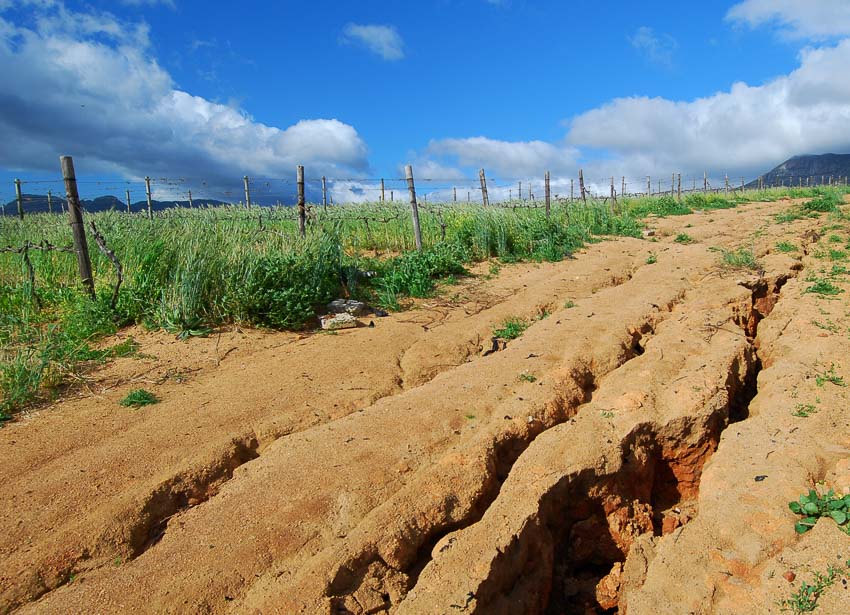It takes hundreds of years for an inch of topsoil to develop, but it can erode in less than a minute. The effects of erosion are devastating, causing damage to homes, buildings, and habitats. But how can erosion be controlled? Explore causes and solutions, and learn how to control erosion through effective methods to protect the soil in your yard.
Understanding Erosion: What is it? What causes it?
Erosion is a geological process in which natural forces wear away and move soil and rock. You may wonder what soil erosion is and how it isn’t just a problem for farmers and people who own shorelines.
It affects homeowners, municipalities, and ecosystems. Sometimes, the effects of erosion aren’t that obvious, but over the long term, significant changes can occur.
The Agents of Erosion
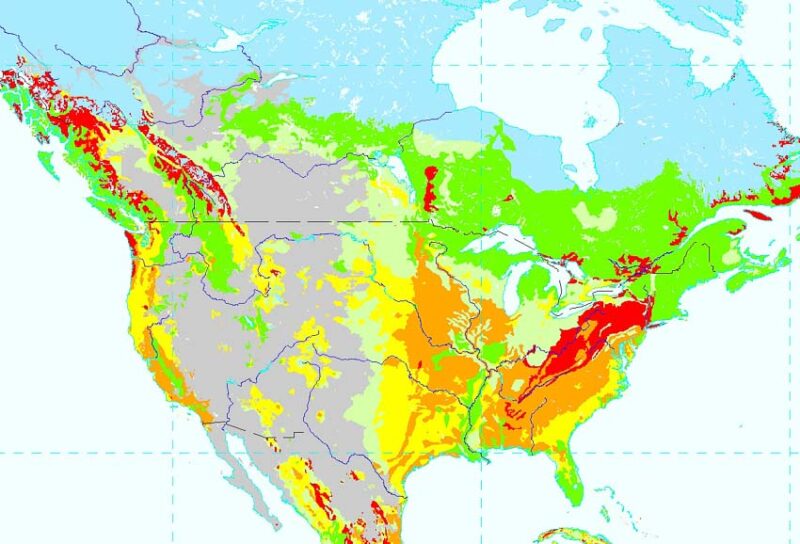
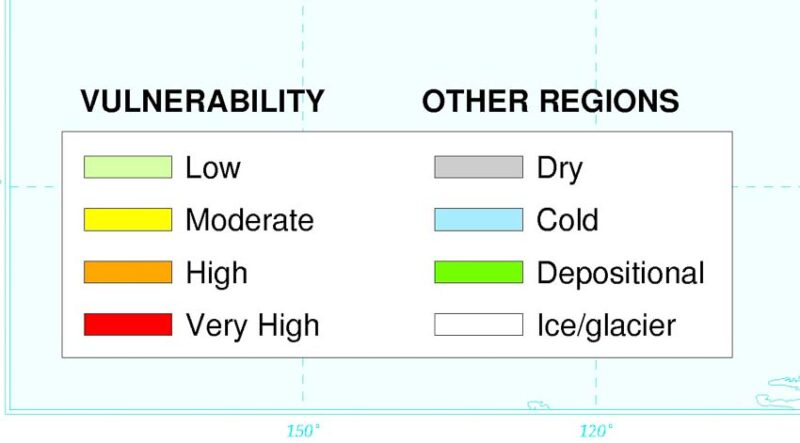
The surface of the Earth has been changing since the dawn of time due to the agents of erosion. Erosion happens when weathered rock materials, including soil particles, are picked up and moved.
Human activities make soils more susceptible to erosion, but there’s a lot that people can do to control the effects of erosion.
Water
Any time you see muddy water, erosion is taking place. Water plays a critical role in erosion, whether it’s waves on the shoreline, water eating away at river banks, or flooding caused by heavy rains.
In extreme cases, soils get waterlogged, which can lead to mudslides.
Water is a primary cause of erosion. Fluvial erosion can create rills and gullies, and streambank erosion pulls away the soil on the banks of lakes, rivers, streams, and oceans.
Gravity
The steeper your land, the more prone it is to erosion due to the force of gravity. When gravity works in conjunction with water, the results can be catastrophic.
The effects of gravity make waterlogged soils more likely to erode, especially in areas disturbed by humans.
Gravity causes mass-movement erosion, and earthquakes can worsen it. It can lead to whole hillsides or mountainsides slipping.
Wind
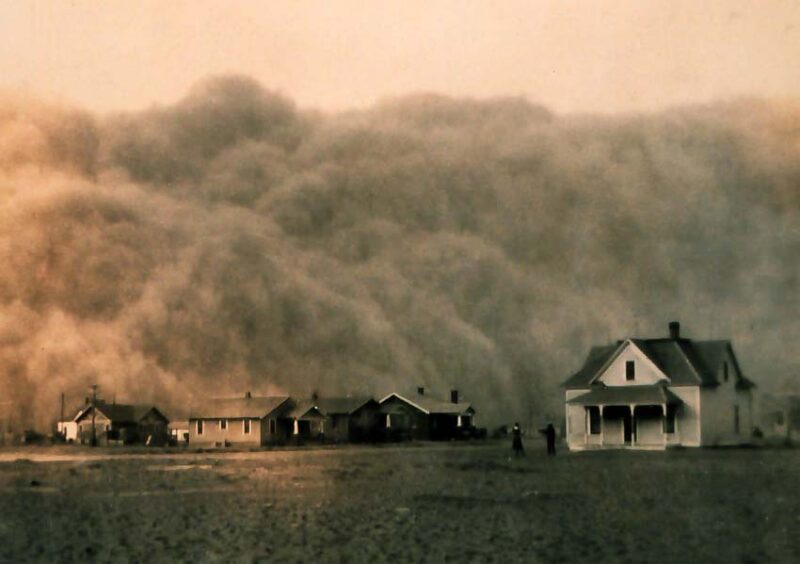
Although wind is a bigger problem in desert regions, farmers lose topsoil every year to wind erosion, and like the Dust Bowl in the 1930s , drought can worsen it. You’ll see wind erosion in desert rock formations like those at Arches National Park in Utah.
Ice
Although slower than other types of erosion, ice plays an important role in moving soils over time. As glaciers advance and retreat, they wear away at rock and soil particles. This carries them to new locations, creating sedimentary layers of soil.
The Impact of Erosion on Land and Environment
How does erosion impact the environment? Different types of erosion have various impacts on the land, but they can all lead to the destruction of habitat and topsoil depletion. Mass-movement erosion events can cause significant loss of human life, and wildlife is often adversely affected by sediment in water sources.
Erosion problems can occur right in your own backyard, caused by rainfall or overwatering. Excess water runoff washes away your topsoil and carries the chemicals you use on your lawn into nearby water sources, leading to algal blooms that have devastating impacts on habitats and wildlife.
If you have a sloped yard, the effects of erosion can cause even more damage. Even on flat ground, the effects of erosion can expose tree roots, wash away flower beds, and cause dust storms in your backyard. Fortunately, there are several ways to stop erosion to protect your soil and the environment.
How Can Erosion Be Controlled?
Humans don’t have much control over major events like flooding, earthquakes, and drought, which can lead to severe erosion problems, but there’s a lot you can do on your own property to protect your soil from the effects of erosion.
Effective Techniques to Control Erosion
No matter your climate, erosion can occur because it’s a natural geological process. Learn how to minimize the effects of erosion in your yard with these effective techniques.
Hardscaping Features
You can avoid erosion by choosing the right hardscaping features for your yard, like retaining walls, rain gardens, or dry creek beds, especially wherever water flow is a problem. Concentrate your efforts on areas where soil compaction and water flow are problems.
Physical Barriers
Using physical barriers to stop the flow of water is an effective approach to erosion and sediment control. You can use temporary barriers like bales of straw, sandbags, and silt fences made of landscape fabric.
Other physical barriers to protect the soil include naturally biodegradable erosion control blankets made of coir, straw, and wood fibers.
Plant Grass
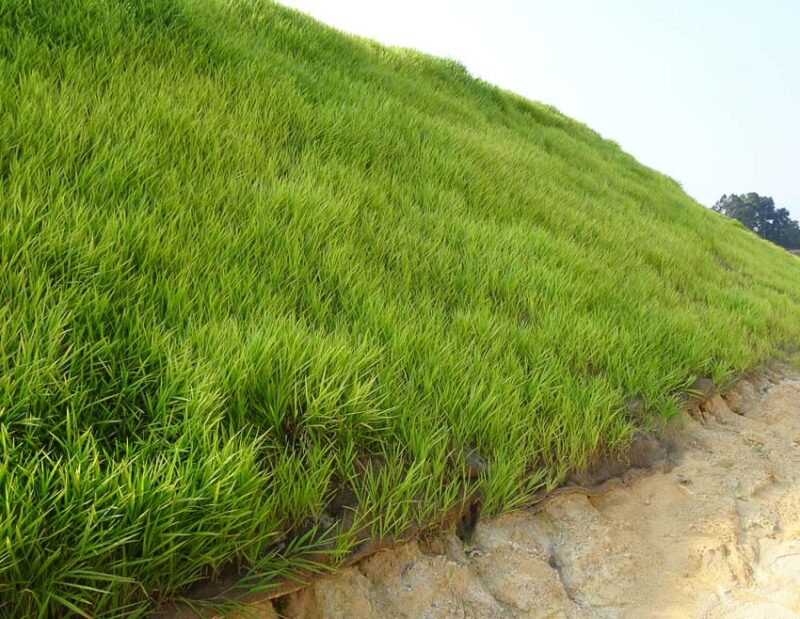
The best grass for erosion control depends on your climate and growing zone.
- Bermuda grass is an excellent choice in the south because it is deep-rooted.
- In shady areas, fescues grow well, and blue and red fescues are some of the best grasses for erosion control because they establish quickly.
- For minimal watering and mowing, choose hardy grasses like buffalo grass.
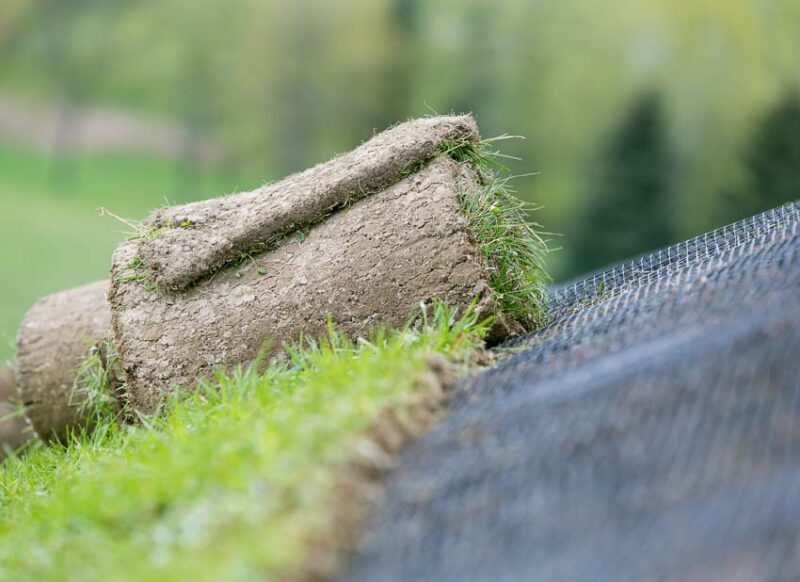
Whether planting grass from seed or installing sod on a slope, use soil stabilization products like erosion control mats to keep the seed and dirt from washing away.
Ground covers
Bare soil absorbs less rainfall than ground covered in vegetation, and it’s also prone to wind erosion. That’s why one of the best erosion control methods is planting ground covers.
It works on flat ground, steep slopes, and everything in between. What you grow depends on your climate and region, but there are many fast-growing, low-maintenance ground covers to choose from.
Riprap
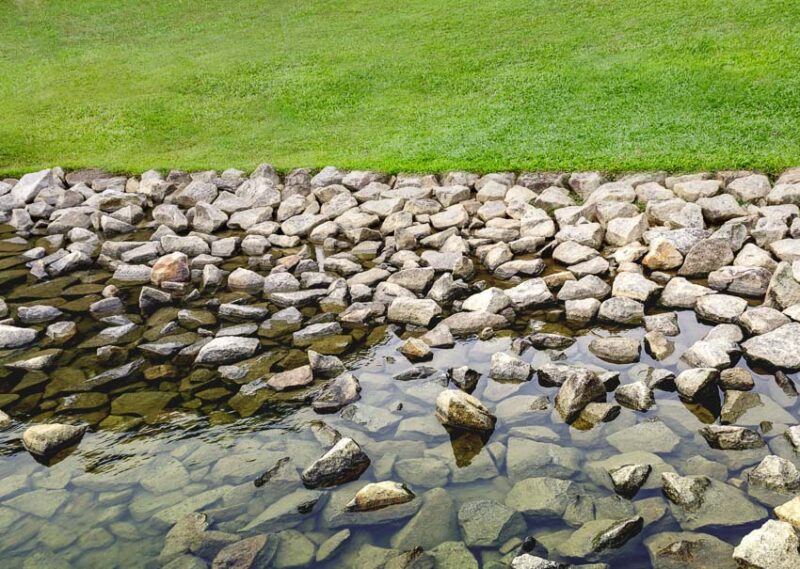
Riprap is a layer of large rocks that stops the flow of water, and it’s one of the best ways to stabilize embankments. Commonly used in road construction, it’s also effective for stabilizing soil when used around your yard, pond banks, and shorelines.
Mulch
Mulch helps protect your soil and stop erosion in areas where it’s hard to grow plants, like around the base of trees. There are a lot of other benefits to mulch, such as moisture retention and balancing soil temperatures.
Some types of mulch also add organic matter to your soil.
Reforestation
When slopes are steep and the soil is susceptible to sliding, reforestation is the best permanent solution to erosion problems. Trees have deep root systems that can stabilize soil in tough areas.
Rainwater Collection Systems
Heavy runoff after rainstorms also causes erosion problems. By installing a rainwater collection and drip watering system, you can use rainwater to irrigate your garden and prevent damage to your landscaping.
Erosion Control Products
Everyone has seen the types of erosion control products that road crews use for problem areas or new road construction. You can employ these methods in your backyard to stop erosion, especially while trying to establish some plants.
Erosion Control Products and Solutions: What’s Available?
There are many commercial products available for preventing erosion. Erosion is a global problem, and countries all over the world are practicing innovative erosion control solutions to combat it.
Commercial Products for Erosion Control
Most erosion control products work by slowing the velocity of water flow, catching sediment, and holding soil in place while vegetation gets established. Here are some of the most common erosion control products available.
Erosion Control Blankets and Wattles
Erosion control blankets and wattles are effective at stopping water flows from carrying away sediments. They slow down the water flow velocity and help filter water runoff.
Wattles are for use on slopes, and you can make both erosion control blankets and wattles from various materials, including straw, coir, and wood fibers.
Geotextiles
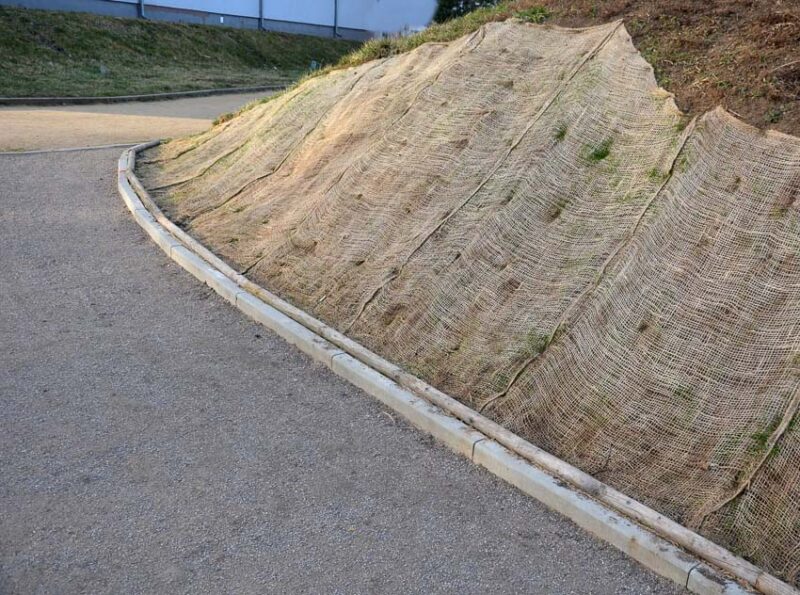
A wide variety of synthetic erosion control materials are available. They are long-lasting compared to biodegradable materials, and you can choose between woven and nonwoven textiles or a geogrid style for steeper slopes.
Depending on the product and application, you install them parallel or perpendicular to the slope. You can install some geogrid products perpendicularly to reduce elongation and creep that comes with holding back heavy soil loads.
They are easy to cut and install, which requires stakes that are essentially long landscaping staples.
Coir Logs.
Lightweight round coir logs last about 2 to 6 years and are 100% biodegradable. They are usually about 10 feet long, packed with coconut fibers, and covered with coconut fiber netting. They are easy to cut and install and are staked in place with long landscaping staples.
Silt Fence
Silt fences are temporary erosion control solutions, often used on construction sites to slow down water flow velocity and reduce erosion.
Also known as filter fences, silt fences are 18 to 30 inches tall. They are partially buried in the ground and staked perpendicularly to hillsides to stop sediment from being carried away and improve water quality by filtering it.
Straw Bales and Sandbags
You typically install straw or hay bales and sandbags in conjunction with other erosion control products, like coir logs and wattles. They are an inexpensive solution to erosion control, and they are both very effective.
You can purchase erosion control bags, including sandbags and snake bags, then fill them with pea gravel or sand and place them wherever water runoff occurs.
Innovative Solutions for Erosion Control
Many companies are looking to Mother Nature for inspiration when it comes to erosion control. Discover new approaches to erosion control with these innovations.
Bioengineered Shorelines
Designed to promote living shorelines, specially woven mesh systems often see use at places like golf courses, lake resorts, and municipal parks. They help stabilize shores and keep water from eating away at the bank while turf grass and other plants get established.
Concrete Mats
Articulated concrete mats are rolls of mesh with concrete cells used to stabilize hillsides and shorelines. They work like riprap, but they are easy to roll out, and they conform to the ground to lay flat.
Because they are connected together, they are less likely to move, and vegetation can get established in the spaces between the concrete cells.
Selecting the Right Plants for Erosion Control
The deep roots of plants help on how to control erosion. People usually select native trees, shrubs, and plants because they grow well in the local climate and soil.
How Do Plants Control Erosion
Plants help to control erosion in several ways.
First, their roots act like deep underground netting, which helps stabilize the soil and keep it in place. Second, vegetation absorbs rainfall, while bare ground does not. Plants also help slow down water flow velocity.
The Best Plants for Erosion Control
Choose plants that naturally have deep roots.
Some herbaceous plants have roots extending 10 to 15 feet below the surface. The best plants for erosion control depend on your climate and region and how you intend to use your planting area.
Erosion Control FAQs
Q1: Why is Erosion Control Necessary?
Erosion results in soil loss, pollution of water sources, property damage, and wildlife habitat destruction. Where erosion occurs, the effects get worse over time without abatement.
Q2: How Do Erosion Control Blankets Work?
Erosion control blankets hold the soil in place, allowing water to run over the top of them. They are an excellent solution for keeping seeds in place on slopes because they are porous enough for water to filter through without washing away the seed.
Q3: What is the Best Grass for Erosion Control?
The best grass for erosion control depends on your climate and region, but annual ryegrass is one of the fastest growing. It establishes quickly and can be planted with perennial grasses suitable for your climate for a long-term solution.
Q4: Can Erosion be Reversed?
The right erosion control solutions can reverse erosion, although severe damage to hillsides and river banks is often irreversible. Farmers can reverse the effects of erosion on their land by adding nutrients, using mulches, and employing no-till farming methods.
Q5: Are there any Natural Methods for Erosion Control?
Encouraging vegetation growth is the most natural method for erosion control. Planting native species, including trees, shrubs, and herbaceous perennials, can prevent erosion, but it can be difficult to establish plants without erosion control products.

